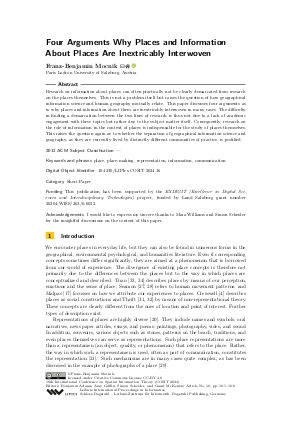LIPIcs.COSIT.2024.16.pdf
- Filesize: 0.52 MB
- 8 pages

 Creative Commons Attribution 4.0 International license
Creative Commons Attribution 4.0 International license

Research on information about places can often practically not be clearly demarcated from research on the places themselves. This is not a problem itself but raises the question of how geographical information science and human geography mutually relate. This paper discusses four arguments as to why places and information about them are inextricably interwoven in many cases. The difficulty in finding a demarcation between the two lines of research is thus not due to a lack of academic engagement with these topics but rather due to the subject matter itself. Consequently, research on the role of information in the context of places is indispensable for the study of places themselves. This raises the question again as to whether the separation of geographical information science and geography, as they are currently lived by distinctly different communities of practice, is justified.


















Feedback for Dagstuhl Publishing